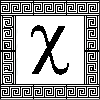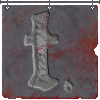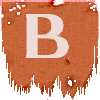Dieroll is determined by your weapon, if you are wielding one. You can determine a weapon's dieroll by statting it, and it looks something like:
Weapon damage: 3 to 24 fast slash, 13 strength to use.
To calculate a weapon's dieroll, divide the second number by the first. In the above example, 24 / 3 = 8. Dieroll is typically presented in a (number 1)d(number 2) format. The first number will be the first number after the "weapon damage" display (3), and the second will be the result of the division of the two numbers (8). Therefore, this weapon has a dieroll of 3d8. The first number indicates how many dice are used, and the second number shows how many sides those dice have. Let's take this weapon and assume that you make a successful attack roll with it. Three 8-sided dice are rolled, resulting in one being 6, the second being 2, and the third being 5. These results are added together for the total damage dealt of 13 (6 + 2 + 5 = 13) for this particular attack. If you were to make another successful attack roll, the dice would be rolled again, resulting in another (or possibly the same) number.
How do you compare weapons based on dieroll? For example, is 4d5 better than 5d4? In this case, 5d4 is better. When comparing weapons that have an equal maximum damage (multiply the first number x the second number, in this case: 20), the higher the first number, the better. This is because the dieroll has a higher minimum (5 instead of 4, because each roll must be at least 1) and because more rolls mean a higher average, so it will therefore deal more damage more consistently. When comparing dieroll that have different maximums, such as 7d5 vs. 2d20, a choice has to be made as to whether you want to do lots of damage some of the time, or some damage all of the time.
If you are not wielding a weapon, dieroll is determined by your fists. New players start off with a dieroll of 2d4. This dieroll can be improved with the unarmed combat skill. The number of dice is always 2, but the number of sides can be greatly increased, higher than is possible with any weapon. Despite the high damage potential, it is usually better to use a weapon than not. You cannot parry or disarm without a weapon, and many weapons can deal damage more consistently - as a result, unarmed combat is usually considered a fallback skill when your weapons are disarmed or unusable. Unarmed combat does improve with use, but it can take a long time.
Damroll is a bonus added to the dieroll. Damroll normally comes from your equipment, though skills such as berserk can boost it temporarily.
Finally, characters with a high strength get an additional bonus of one damroll for every two strength points above 18.
- dieroll + damroll + strength bonus = base damage of attack
Remember that your base damage is the damage you would do if the target were an ideal, completely unarmored target. For real targets with armor, some of the base damage may be absorbed by the armor. For heavily armored targets, you may land a blow every time, yet never injure your target due to armor.
Mechanics of Melee Combat - Prev - 1 2 3 4 - Next










